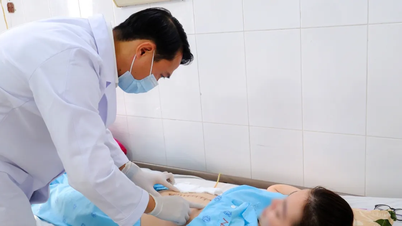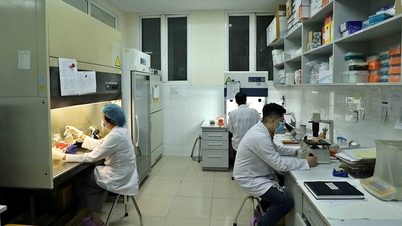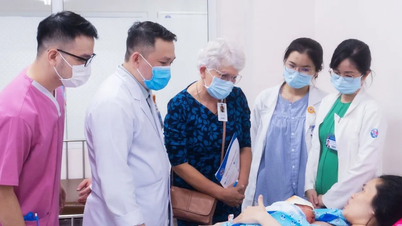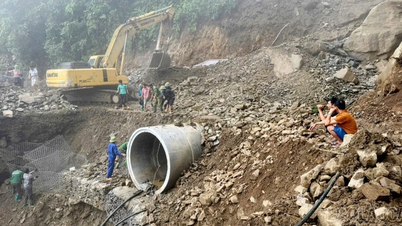Persistent abdominal pain, unexpectedly cancer has metastasized
Ms. Th., 48 years old, was admitted to the hospital with a dull abdominal pain that lasted for nearly two weeks and an abnormally enlarged abdomen. Thinking that this was just a symptom of hormonal disorders during pre-menopause, she subjectively did not go to the doctor early.
 |
| Illustration photo. |
However, when she came to the hospital for examination, the test results showed that her ovary had a tumor measuring 48x55x47 mm along with hundreds of polyps scattered on the surface of the peritoneum, the membrane that covers the organs in the abdominal cavity.
Dr. Huynh Ngoc Thu Tra, Obstetrics and Gynecology Center, Tam Anh General Hospital, Ho Chi Minh City, said that the fatty tissue in the patient's abdomen was infiltrated, edematous, congested and lost its normal structure.
A 3-5 mm tissue biopsy confirmed that Ms. Th. had ovarian cancer that had metastasized to the peritoneum. Doctors consulted and developed a comprehensive treatment plan, combining surgery, systemic and local chemotherapy, and controlling ascites to improve the patient's quality of life.
Ovarian cancer with peritoneal metastasis is a condition in which cancer cells spread from the ovary and invade the peritoneum. This type of cancer is often only detected at a late stage because the initial symptoms are unclear and can be easily confused with digestive or endocrine disorders.
Common symptoms include bloating, flatulence, dull pelvic pain, early satiety, loss of appetite, weight loss and persistent indigestion. These symptoms are often overlooked, especially in premenopausal women, because they can be easily mistaken for age-related or weight-related changes.
According to Dr. Thu Tra, most cases of cancer metastasis to the peritoneum originate from organs in the abdominal cavity such as the ovaries, stomach, intestines... Extra-abdominal cancers such as breast cancer, lung cancer or malignant melanoma metastasis to the peritoneum only account for about 10%.
What is worrying is that some patients only discover the disease when they experience abdominal distension, ascites or intestinal obstruction, signs that the cancer is already in its late stages.
Ovarian cancer is a group of malignant diseases originating from the ovaries, fallopian tubes or from the peritoneum itself.
According to the American Cancer Society, four early signs that are often overlooked include persistent bloating, pelvic pain or heaviness, feeling full quickly, and frequent urination. Pelvic pain is often dull, can resemble menstrual cramps, is sometimes widespread or localized to one side, and is accompanied by a feeling of mild indigestion and bloating.
If these symptoms persist and increase in severity, especially in women over 40 years old or postmenopausal, attention should be paid and early medical examination should be sought to detect the disease promptly.
Ovarian cancer, if detected early, has a better prognosis. Listening to your body, monitoring for unusual signs and having regular health check-ups are effective ways to prevent and detect this dangerous disease early.
Emergency surgery to save a woman with a ruptured kidney tumor
Ms. V., 67 years old, living in Ho Chi Minh City, was hospitalized with severe abdominal pain, left flank pain, nausea and blood in the urine.
Hospital examination results showed that she had a suspected ruptured kidney tumor and was bleeding severely, threatening her life due to acute blood loss.
According to Associate Professor, Dr. Vu Le Chuyen, Director of the Center for Urology - Nephrology - Andrology, CT scan results showed that the patient had a large blood clot around the left kidney and a tumor about 4 cm in size in the middle third of the kidney.
The worrying thing is that the tumor may have ruptured, causing massive bleeding. Previously, Ms. V. had been examined at another hospital and was found to have a left kidney tumor with a hematoma under the kidney, but had not received timely intervention.
Faced with the critical situation, doctors at the Urology - Nephrology - Andrology Center immediately performed emergency surgery on the patient. Associate Professor Chuyen said that surgery in this case was very difficult due to the large amount of bleeding that obstructed vision, high risk of blood loss and possibly forced removal of the entire left kidney.
With the support of the Da Vinci Xi surgical robot system, the team performed the surgery with high precision and speed. The thin, flexible robotic arms helped the doctor reach deep into the kidney hilum, dissect the connective tissue around the kidney, clamp the blood vessels and determine the location of the ruptured tumor.
The image magnified by the robot camera is 15 times larger than the real image, helping the doctor see every detail clearly, quickly remove the kidney with the tumor and stop the bleeding for the patient. The surgery took about 45 minutes and was successful beyond expectations.
A day after the surgery, Mrs. V. recovered well, was able to sit up, and practice walking gently. She emotionally shared her feelings about being saved by the skin of her teeth, and sent her deep gratitude to the doctors and nurses. She was discharged after 3 days and scheduled for regular check-ups to monitor and prevent the risk of recurrence.
According to Master, Doctor Nguyen Tan Cuong, Deputy Head of Urology Department, Center for Urology - Nephrology - Andrology, ruptured kidney tumor is a very dangerous condition, often causing internal bleeding, severe pain in the flank and back and can lead to sudden drop in blood pressure, also known as Wunderlich syndrome. Most cases of spontaneous perirenal bleeding are due to ruptured kidney tumor. The cause can be benign tumors such as angiomyolipomas, or kidney cancer as in the case of Ms. V.
The mechanism of rupture of renal cancer tumors is not clearly determined, but may be related to the tumor invading blood vessels, causing renal vein thrombosis or tissue necrosis, growing too quickly causing rupture of the renal capsule. Some cases of tumor rupture may be due to minor trauma in people with kidney disease such as large renal cysts, hydronephrosis, vascular malformations.
Warning symptoms include sudden and severe flank pain, blood in the urine, nausea, vomiting, fever, and in severe cases, dizziness and fainting due to blood loss. If not treated promptly, a ruptured kidney cyst can lead to serious complications such as hemorrhagic shock, hematoma infection or acute kidney injury.
Treatment of a ruptured renal tumor is a surgical emergency. First of all, resuscitation, stabilization of blood pressure and hemostasis are required. Treatment methods include embolization to block the blood vessels that feed the tumor to stop bleeding and preserve kidney function, or surgical removal of part or all of the kidney if the damage is severe. With the support of modern robotic technology, the ability to save patients in critical situations such as ruptured malignant renal tumors has been significantly improved.
Ten years of difficulty swallowing due to cardiac spasm
Ms. C., 44 years old, residing in Dong Thap , has just been successfully treated for achalasia after more than 10 years of living with persistent dysphagia. She had previously undergone balloon dilation once, but the condition quickly relapsed after only one month.
Since then, eating has become a nightmare for her. Every time she eats only a few spoonfuls of rice, she has to drink water to push the food down. Many times, she cannot even swallow a small sip of water, forcing her to vomit it back up. This prolonged condition causes her to often regurgitate food into her nose at night, making it difficult for her to sleep, and gradually developing serious digestive disorders.
She was examined at the hospital. Dr. Do Minh Hung, Director of the Center for Endoscopy and Endoscopic Surgery of the Digestive System, said that the results of the X-ray of the esophagus with contrast medium showed that the esophagus was dilated, filled with fluid, and the end was narrowed with a characteristic "bird's beak" image.
High resolution esophageal motility manometry (HRM) revealed dysfunction of the esophageal motility and both the upper and lower esophageal sphincters. Gastroscopy using the Olympus EVIS X1 CV - 1500 system with up to 150x magnification demonstrated reflux esophagitis, antral mucosa congestion and superficial duodenal ulceration.
Achalasia is a disorder of esophageal motility, causing the lower esophageal sphincter to not open in time to move food down to the stomach, causing stagnation, choking and reflux. Ms. C. was diagnosed with type 2 achalasia, a condition in which the entire esophagus increases pressure evenly, not creating the necessary peristaltic waves to push food down, making the swallowing process extremely difficult and painful.
If not treated promptly, achalasia can lead to dangerous complications such as aspiration pneumonia, due to food and liquid reflux into the trachea and lungs, or esophageal cancer due to damage to the esophageal mucosa and prolonged chronic inflammation.
Due to the severe progression and history of failed balloon dilation treatment, the doctor prescribed peroral endoscopic myotomy (POEM), a modern endoscopic method that leaves no scars, is less painful and has long-term effectiveness.
During the surgery, the surgeon uses an electric knife to open the esophageal mucosa, creating a cavity between the muscle layer and the mucosa layer, then cuts the lower esophageal sphincter with a 6 cm long cut in the esophagus and 2 cm in the stomach. Finally, the opening is closed with 5 clips.
After surgery, Ms. C. no longer had any difficulty swallowing, no pain, and X-ray results showed that food passed through the esophagus normally, with no more stagnation.
She was discharged from the hospital after only one day, and was given a recovery diet according to instructions: starting with liquid foods for the first week, then gradually moving to solid foods and chewing thoroughly, and regular check-ups to monitor the treatment results.
Achalasia is a rare disease, the specific cause is currently unknown, so there is no specific prevention method. However, patients with symptoms such as difficulty swallowing, regurgitation of undigested food, vomiting, unexplained chest pain, weight loss should see a gastroenterologist early for proper diagnosis and intervention.
Depending on the patient's condition and health, treatment methods can include medication, botulinum injection, balloon dilation of the esophagus, or endoscopic esophageal sphincterotomy, either abdominally (Heller) or orally (POEM), as in Ms. C's case.
Source: https://baodautu.vn/tin-moi-y-te-ngay-118-mac-ung-thu-di-can-vi-bo-qua-trieu-trung-dau-bung-thong-thuong-d355446.html


![[Photo] Students of Binh Minh Primary School enjoy the full moon festival, receiving the joys of childhood](https://vphoto.vietnam.vn/thumb/1200x675/vietnam/resource/IMAGE/2025/10/3/8cf8abef22fe4471be400a818912cb85)




![[Infographic] Notable numbers after 3 months of "reorganizing the country"](https://vphoto.vietnam.vn/thumb/1200x675/vietnam/resource/IMAGE/2025/10/4/ce8bb72c722348e09e942d04f0dd9729)




























![[Photo] Prime Minister Pham Minh Chinh chairs meeting to deploy overcoming consequences of storm No. 10](https://vphoto.vietnam.vn/thumb/1200x675/vietnam/resource/IMAGE/2025/10/3/544f420dcc844463898fcbef46247d16)




































































Comment (0)